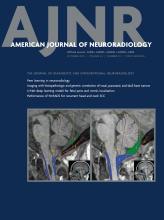Research ArticleHead & Neck
Peritumoral Signal on Postcontrast FLAIR Images: Description and Proposed Biomechanism in Vestibular Schwannomas
John C. Benson, Matt L. Carlson and John I. Lane
American Journal of Neuroradiology October 2023, 44 (10) 1171-1175; DOI: https://doi.org/10.3174/ajnr.A7979
John C. Benson
aFrom the Department of Radiology (J.C.B., J.I.L.), Mayo Clinic, Rochester, Minnesota
Matt L. Carlson
bDepartment of Otolaryngology-Head and Neck Surgery (M.L.C.), Mayo Clinic, Rochester, Minnesota
John I. Lane
aFrom the Department of Radiology (J.C.B., J.I.L.), Mayo Clinic, Rochester, Minnesota

References
- 1.↵
- Lin EP,
- Crane BT
- 2.↵
- 3.↵
- 4.↵
- 5.↵
- 6.↵
- 7.↵
- 8.↵
- Bonneville F,
- Savatovsky J,
- Chiras J
- 9.↵
- 10.↵
- 11.↵
- Welby JP,
- Benson JC,
- Lohse CM, et al
- 12.↵
- 13.↵
- 14.↵Committee on Hearing and Equilibrium guidelines for the evaluation of hearing preservation in acoustic neuroma (vestibular schwannoma); American Academy of Otolaryngology-Head and Neck Surgery Foundation, INC. Otolaryngol Head Neck Surg. 1995;113:179–80 doi:10.1016/S0194-5998(95)70101-X pmid:7675475
- 15.↵
- 16.↵
- 17.↵
- 18.↵
- 19.↵
- 20.↵
- 21.↵
- Kim DY,
- Lee JH,
- Goh MJ, et al
- 22.↵
- 23.↵
- 24.↵
- 25.↵
- Panyaping T,
- Punpichet M,
- Tunlayadechanont P, et al
- 26.↵
In this issue
American Journal of Neuroradiology
Vol. 44, Issue 10
1 Oct 2023
Advertisement
John C. Benson, Matt L. Carlson, John I. Lane
Peritumoral Signal on Postcontrast FLAIR Images: Description and Proposed Biomechanism in Vestibular Schwannomas
American Journal of Neuroradiology Oct 2023, 44 (10) 1171-1175; DOI: 10.3174/ajnr.A7979
0 Responses
Jump to section
Related Articles
- No related articles found.
Cited By...
- Vestibular Schwannoma-Related Increased Labyrinthine Postgadolinium 3D-FLAIR Signal Intensity and Association with Hearing Impairment
- The "Outline Sign": Thin Hyperenhancing Perimeter as an MR Imaging Feature of Meningioma. A Useful Tool in the Temporal Bone Region for Differentiating Meningiomas from Schwannomas and Paragangliomas
- Imaging Findings Post-Stereotactic Radiosurgery for Vestibular Schwannoma: A Primer for the Radiologist
This article has been cited by the following articles in journals that are participating in Crossref Cited-by Linking.
- Girish Bathla, Parv M. Mehta, John C. Benson, Amit K. Agrwal, Neetu Soni, Michael J. Link, Matthew L. Carlson, John I. LaneAmerican Journal of Neuroradiology 2024 45 9
- John P. Welby, Nicholas M. Baumel, Ghazal S. Daher, Armine Kocharyan, Christine M. Lohse, Girish Bathla, Matthew L. Carlson, John I. Lane, John C. BensonAmerican Journal of Neuroradiology 2025 46 3
- Anil K. Vasireddi, Katherine L. Reinshagen, Donghoon Shin, Laura V. Romo, Amy F. JulianoAmerican Journal of Neuroradiology 2025 46 2
More in this TOC Section
Similar Articles
Advertisement











